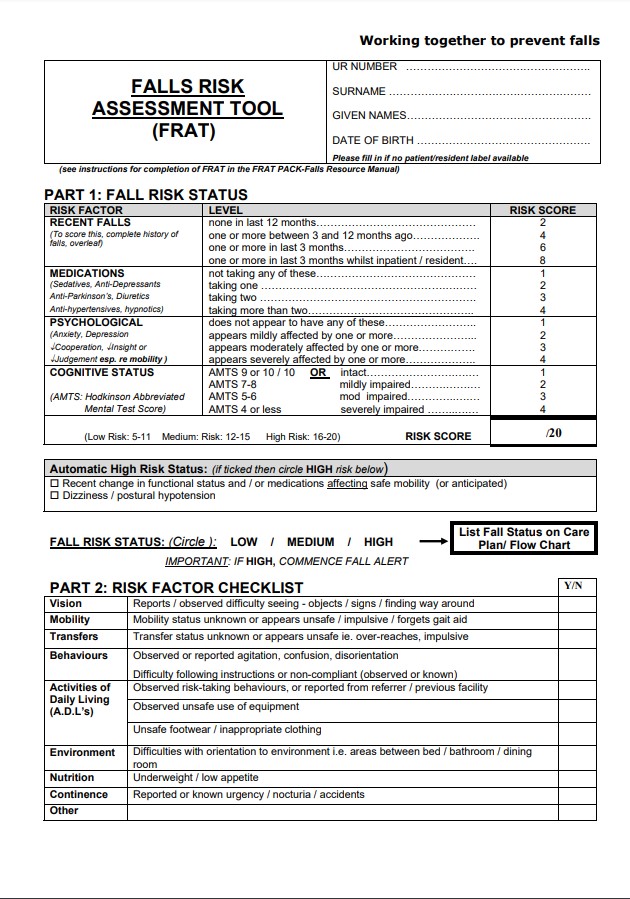Dementia Fall Risk - An Overview
Dementia Fall Risk - An Overview
Blog Article
Examine This Report on Dementia Fall Risk
Table of ContentsThe Buzz on Dementia Fall RiskAbout Dementia Fall RiskThe Greatest Guide To Dementia Fall RiskTop Guidelines Of Dementia Fall Risk3 Simple Techniques For Dementia Fall Risk
The FRAT has three areas: drop danger condition, risk element list, and action strategy. An Autumn Risk Standing includes data regarding history of current falls, medicines, mental and cognitive condition of the individual - Dementia Fall Risk.If the client ratings on a danger element, the corresponding number of points are counted to the individual's fall danger rating in the box to the much. If a person's loss risk score totals 5 or greater, the individual is at high risk for drops. If the patient ratings just four points or reduced, they are still at some threat of falling, and the nurse should use their ideal professional evaluation to handle all fall danger aspects as component of an alternative care strategy.
These conventional approaches, in general, help establish a risk-free setting that minimizes accidental drops and defines core precautionary actions for all patients. Indicators are vital for people at risk for drops.
The Definitive Guide for Dementia Fall Risk
Wristbands should include the client's last and first name, date of birth, and NHS number in the UK. Details ought to be printed/written in black versus a white history. Just red color should be used to signify special person standing. These recommendations are consistent with present growths in patient identification (Sevdalis et al., 2009).
Things that are also much might need the person to connect or ambulate unnecessarily and can possibly be a threat or add to drops. Helps avoid the client from going out of bed without any support. Registered nurses react to fallers' call lights quicker than they do to lights started by non-fallers.
Visual disability can considerably trigger falls. Hip pads, when used correctly, might reduce a hip fracture when fall takes place. Maintaining the beds closer to the floor reduces the threat of falls and major injury. Positioning the bed mattress on the floor dramatically decreases loss danger in some medical care settings. Low beds are designed to lessen the range an individual falls after moving out of bed.
Not known Details About Dementia Fall Risk
Individuals who are high and with weak leg muscular tissues who try to rest on the bed from a standing setting are most likely to drop onto the bed because it's also low for them to lower themselves safely. If a high client efforts to get up from a reduced bed without help, the client is most likely to drop back down onto the bed or miss out on the bed and fall onto the floor.
They're created to promote timely rescue, not to avoid falls from bed. Audible alarms can additionally advise the person not to rise alone. Making use of alarm systems can likewise be an alternative for physical restrictions. Other than bed alarms, enhanced guidance for risky individuals additionally may aid avoid drops.

Individuals with a shuffling stride increase loss chances dramatically. To decrease autumn risk, footwear ought to be with a little to no heel, thin soles with slip-resistant walk, and support the ankle joints. Suggest person to make use of nonskid socks to avoid the feet from gliding upon standing. Encourage patients to put on ideal, well-fitting shoesnot nonskid socks for motion.
The Best Strategy To Use For Dementia Fall Risk
Clients, particularly older grownups, have actually minimized aesthetic capability. Lighting an unfamiliar setting helps boost exposure if the individual should obtain up during the night. In a study, homes with ample lighting record fewer falls (Ramulu et al., 2021). Renovation in illumination in your home might lower autumn prices in older grownups (Dementia Fall Risk). Making use of stride belts by all wellness treatment companies can promote safety when assisting clients with transfers from bed to chair.

Sitters work for ensuring a protected, safeguarded, and secure setting. Nevertheless, research studies demonstrated really low-certainty evidence that sitters decrease loss danger in intense care medical facilities and only moderate-certainty that choices like video clip monitoring can lower sitter use without enhancing loss risk, suggesting that caretakers are not as valuable as at first believed (Greely et al., 2020).
Dementia Fall Risk Things To Know Before You Get This

Raised physical fitness minimizes the threat for falls and limits injury that is endured when loss transpires. Land and water-based workout programs may be similarly helpful on site here equilibrium and gait and consequently minimize the threat for drops. Water workout may contribute a positive benefit on balance and stride for women 65 years and older.
Chair Increase Workout is an easy sit-to-stand workout that helps enhance the muscular tissues in the thighs and butts and improves wheelchair and freedom. The objective is to do Chair Surge exercises without making use of hands as the customer comes to be more powerful. See sources section for a thorough guideline on how to execute Chair Increase see page exercise.
Report this page